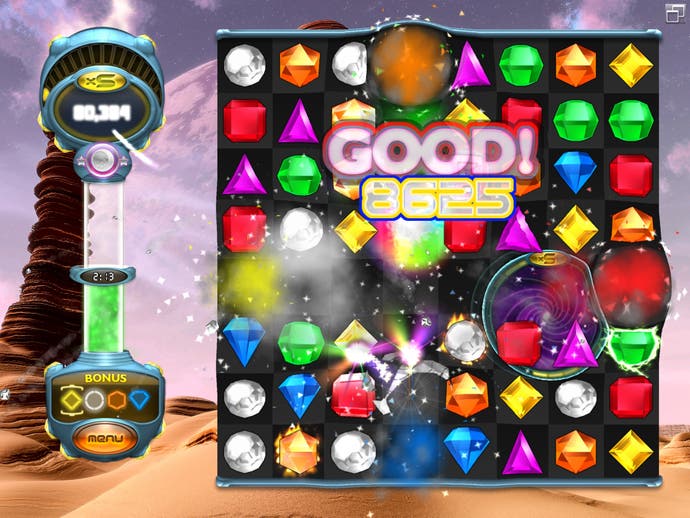Bejeweled Twist
Turn around.
The press release for Bejeweled Twist is full of lies! There is not "no doubt" that "this is the world's greatest casual videogame"; just ask the world's millions of Tetris and Peggle fans. Bejeweled Twist does not "revolutionise fun". The visual and audio effects are not "stunning". And it's incorrect to say that "virtually every aspect of Bejeweled Twist is new". It's still played on a grid filled with multi-coloured gems. The gameplay still involves matching gems of the same colour to make them disappear, thereby racking up points. There are still special gems that have different effects when matched. The visuals are pretty enough, the music is as gently hypnotic as always and the nice clinky sound effects are as nice and clinky as they've ever been.
So not many aspects of Bejeweled Twist are new.
That said, not everything in the press release is a lie. There has been one simple yet fundamental change to the gameplay, and it does put "a completely new spin" on the game. It really does mean that Bejeweled Twist can be "relaxing, challenging, exciting or incredibly strategic, depending on your mood". In the original Bejeweled, the gameplay was about switching gems with their horizontal or vertical neighbours. In Bejeweled Twist, the gameplay revolves around, well, revolving them.
Instead of clicking on a single gem, you click on a two-by-two group of four. This causes each gem to rotate one place clockwise. If this results in three or more gems of the same colour becoming lined up horizontally or vertically, they disappear - just like in old Bejeweled. But in Bejeweled Twist, you don't have to make a match with every single move. You can keep clicking and rotating gems for as long as you like without scoring any points, and never see the "No more moves" message.

At first, playing in Classic mode, it's hard to locate any challenge whatsoever. But as you progress, bomb gems start to appear. These have a numerical counter that clicks down with each move you make. To defuse them you have to match them with like-coloured gems, and this is trickier in later levels when you might see three or four bomb gems on-screen at once.
Other new gem types include locked ones, which you can't move around the grid, limiting your range of possible moves. There are also lumps of coal that can be moved but not matched, and only destroyed by flame or lightning gems. Flame gems appear when you match up four gems of the same colour, and destroy everything in the vicinity when they're matched, and lightning gems are the reward for a five-strong match, and take out full rows horizontally and vertically.
It's fun working out what all these new gems do, and how they can be used to pull off ever-longer chains. It's perfectly possible to spend hours playing with the special gems, defusing bombs as soon as they appear and not worrying about anything else. This fills up the meter on the left-hand side, and once it's full, you'll move onto the next level.
But the real depth comes from the added optional challenges. For starters, a colour-coded sequence is displayed at the bottom of the gem tube. It might run red-yellow-blue-yellow, for example. Matching four groups in that colour order, without interruption, will earn you a bonus that explodes any bombs on the screen, taking the surrounding gems with them. Achieving the sequence depends on the entire arrangement of the grid, and it's often harder than it might sound.
Meanwhile, at the top of the tube is a score multiplier meter, which is divided into sections that fill up as you match stuff with successive moves. Go all the way to 10x and you get a special fruit gem that takes out loads of others.









